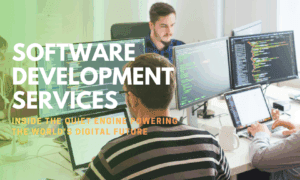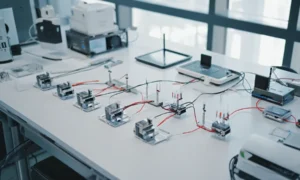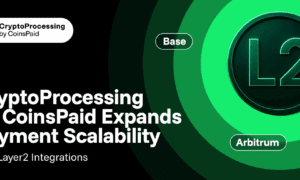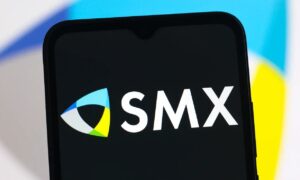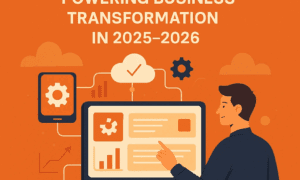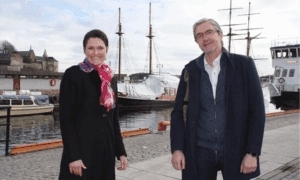How Do Businesses Prioritize Innovation in Product Development?
In the dynamic world of product development, successful innovation methodologies are crucial. We’ve gathered insights from founders and CEOs on their tried-and-true strategies, featuring examples ranging from an iterative R&D methodology with client engagement to a rapid prototyping approach for project management software. Explore these fifteen diverse and proven methods that have led to remarkable product successes.
- Iterative R&D Methodology with Client Engagement
- Scrum Methodology Yields 3D Printer Success
- Co-Developed Energy Solution with BPW
- Simplicity-Driven Design Achieves User-Friendly Extension
- Design Thinking Shapes User-Centric Mobile App
- Human-Centric Approach to Air Quality System
- Agile, Design Thinking, and Lean Startup Fusion
- User-Centric Design Thinking for Energy-Efficient Machine
- Hybrid Agile and User-Centric Methodology Proves Effective
- Improving an AI Video Generator with User Feedback
- Culture of Continuous Experimentation and Lean-Agile Integration
- Six Sigma Methodology Enhances Product Quality
- Jobs-to-Be-Done Framework Guides Product Evolution
- Open Innovation Approach with Zero Waste Initiative
- Rapid Prototyping Methodology for Project Management Software
Iterative R&D Methodology with Client Engagement
As a software R&D consultancy, we partner with our clients on numerous projects to create custom tech solutions. We employ a multifaceted, iterative methodology to innovation and design that is flexible enough to cater to the specific needs and timelines of our clients.
After initial conversations to understand the scope, challenges, and goals of our clients, we form an action group of our R&D engineers—including those with relevant experience and others with transferable knowledge who positively contribute to the ideation of novel ideas. The action group then begins research and familiarizes themselves with current state-of-the-art solutions, while also considering more creative solutions from seemingly unrelated fields.
A detailed research plan is created, comparing our proposed custom solution against alternatives and explaining the solution in technical detail. An in-depth session with the client is held, addressing opportunities, risks, timelines, and costs, to ensure everyone is on the same page before proceeding with development.
Following an agile delivery cadence, our team executes the development of the software product. Working toward each intermediate milestone until the solution is developed, we maintain a single point of contact with the client to keep them completely up-to-date on progress. After completion, we can offer technical support and assistance with the process to protect intellectual property.
Dentrino On-Demand, an AI-generated smile makeover simulation, is just one of the many products developed following our process. Our client came to us with a first-generation product that required an overhaul to allow for greater automation, functionality, and quality. Working through an iterative improvement model, our team combined new and existing ideas to develop the solution that achieved the project’s intended goals.
Balázs Keszthelyi, Founder & CEO, TechnoLynx
Scrum Methodology Yields 3D Printer Success
At our business, we adhere to the Scrum method for developing products. As a Certified Scrum Master, my role involves coordinating our team of product owners and developers through organized sprints. We keep things clear and open by planning carefully and holding regular Scrum meetings.
The successful creation of our innovative DF2 Solution 3D printer was made possible by applying Scrum principles. The iterative nature of Scrum allowed us to adapt plans quickly, regularly check progress, and prioritize customer feedback, ensuring we not only met but exceeded customer expectations. Scrum has really made a significant impact, transforming our product development environment into one that’s dynamic and efficient.
Olivia Tian, Marketing Director, Raise3D
Co-Developed Energy Solution with BPW
Understanding the challenges faced by transport refrigeration companies—balancing energy consumption, uptime, sustainability targets, and access to Ultra-Low Emissions Zones—we partnered with BPW to co-develop a solution that would address these concerns directly.
The Thermo King AxlePower harnesses wasted energy from the vehicle’s axle and converts it into electricity, which is then used to power the refrigeration unit. This 100% tractor-independent, fuel-free trailer cooling solution drastically reduces the environmental impact of refrigerated trailers and eliminates the sustainability premium with no compromise on performance.
Laurent Debias, Product Management and Regulatory Affairs Leader, Trane Technologies
Simplicity-Driven Design Achieves User-Friendly Extension
Our business follows a simplicity-driven innovation methodology in product development, focusing on user-friendly design principles. A prime example is our commitment to limiting all screens to feature just one simple button. This approach ensures that users know exactly what to do next, significantly reducing confusion and support costs.
An exemplary product developed using this methodology is ProfilePro, an AI-powered SEO Chrome extension. With over 10,000 downloads, ProfilePro has achieved remarkable success, demonstrated by the fact that it generates less than one support ticket per week. This success underscores the effectiveness of our simplicity-driven approach, proving that making technology accessible and straightforward can lead to high user satisfaction and reduced operational costs.
Justin Silverman, Founder & CEO, Merchynt
Design Thinking Shapes User-Centric Mobile App
The ideas of design thinking are seamlessly integrated into the way we make products at our company. For example, our mobile app for managing tasks is a great example of how well this method works.
We made a prototype that was not only easy to use but also solved the exact problems our target audience was having by putting ourselves in the shoes of the users, carefully describing their needs, and coming up with creative solutions. We created a final product that people like by testing and improving it over and over again. This is what user-centered design is all about.
Julian Patrick, Founder, Stovefitter’s Warehouse
Human-Centric Approach to Air Quality System
True innovation comes from understanding unmet human needs, not just pushing technology. Our process always starts by deeply immersing ourselves in people’s experiences and pain points related to indoor air quality through observation and candid conversations.
We then rapidly prototype solutions based on those insights and iterate concepts through real-world user testing—not assumptions. It’s about solving root problems simply.
Our new air monitoring system is a prime example. Research showed that people lacked visibility into indoor air quality but didn’t want overwhelming complexity. So, we designed an intuitive system that seamlessly samples the air and translates data into straightforward visualizations and assessments that people can actually understand and act on.
Gideon Ruben, CEO, Your IAQ
Agile, Design Thinking, and Lean Startup Fusion
At Zibtek, we’re dedicated to fostering innovation through a dynamic product-development methodology. Our approach combines elements of agile development, design thinking, and lean-startup principles to drive creativity, collaboration, and rapid iteration.
One example of a product successfully developed using this approach is our Oncourse. By leveraging agile methodologies, we were able to break down complex features into manageable chunks and deliver incremental value to our users with each two-week sprint. Design-thinking principles guided our user-centric approach, ensuring that we stayed laser-focused on solving real-world problems and delivering intuitive, user-friendly experiences. And with lean-startup principles, we maintained a relentless focus on experimentation and feedback, allowing us to quickly adapt to changing market dynamics and customer needs.
The result? A groundbreaking product that not only met but exceeded user expectations, driving continuous value for both our customers and our business. Through our innovative product-development methodology, we continue to push the boundaries of what’s possible, delivering cutting-edge solutions that drive growth and impact in the ever-evolving tech landscape.
Cache Merrill, Founder, Zibtek
User-Centric Design Thinking for Energy-Efficient Machine
Our product development philosophy at DoDo Machine hinges on user-centric design thinking. We immerse ourselves in the users’ environment to empathize with their challenges, which guides our innovation process. A standout success story is our energy-efficient fabricator machine, designed for small businesses.
By directly involving our target users in the ideation and testing phases, we uncovered unique insights that shaped a more intuitive, efficient machine. This design-thinking approach not only led to a successful product but also strengthened our bond with the community we serve.
Mark Sheng, Project Engineer, DoDo Machine
Hybrid Agile and User-Centric Methodology Proves Effective
In developing products for my ventures, I’ve leaned heavily into a hybrid innovation methodology that combines Agile development practices with user-centric design. This approach allows for rapid iteration based on direct feedback from users, ensuring that the products developed not only meet but exceed market expectations.
Take, for example, the development of the Crystal Clear system, a comprehensive web, practice management, CRM, and marketing platform for local medical practices. By engaging directly with healthcare professionals to understand their unique needs and challenges, we were able to iterate quickly, refining the system based on real-world use and feedback. This methodology enabled us to deliver a solution that not only streamlined operations for medical practices but also significantly enhanced the patient engagement process. The success of this product was marked by its recognition in the Inc. 500 list, highlighting its impact and the effectiveness of our development approach.
Similarly, with Anthem Business Software, we applied a similar rapid-iteration, user-feedback-driven process. Understanding the challenges small businesses faced in competing against larger corporations, we focused on creating a CRM and marketing platform that was both powerful and accessible. This process involved continuous iteration based on user feedback, allowing us to adjust features, usability, and support to precisely meet the needs of our target users.
The development of FSK (Find, Serve, Keep), a mobile game aimed at simplifying and gamifying customer relationship management for small business owners, followed a similar path. We started with a core concept that addressed a specific challenge and evolved the game through stages of prototyping, testing, and refining based on user input. This iterative process, guided by direct feedback from potential users in our target market, ensured that the final product was both engaging and effectively educational.
Through these experiences, I’ve found that the key to successful product development lies in the ability to quickly adapt and refine product offerings based on genuine user needs and feedback. This blend of agility, user focus, and constant iteration has been instrumental in developing solutions that not only meet the market demand but do so in a way that truly resonates with users.
Adam Degraide, Chief Executive Officer, BamBamTastic Games
Improving an AI Video Generator with User Feedback
As the CTO of Elai.io, I follow an iterative innovation methodology in our product development process. This approach involves constant feedback loops and adjustments to enhance our AI video generator tool, leveraging the latest trends in the AI field.
By adopting deep-learning models, we have significantly improved the quality and realism of the generated videos. We continually incorporate user feedback into our development process. Through analytics and user surveys, we identify areas for improvement and prioritize features that enhance our capabilities. This agile approach ensures that our product remains at the forefront of AI innovation, meeting the evolving needs of our users.
Alex Uspenskyi, Founder & CTO, Elai
Culture of Continuous Experimentation and Lean-Agile Integration
Our approach to innovation in product development isn’t just a process; it’s a journey we have started with curiosity and courage. Here’s a dive into how we innovate and a few examples that illustrate our unique approach.
Innovation at our organization isn’t a department; it’s a culture. We foster an environment where experimentation is encouraged, and “failures” are seen as stepping stones. Every team member is empowered to suggest and test new ideas. This approach is like having a lab within a workshop, where every tool and piece of technology is a potential ingredient for the next breakthrough.
Toggl Plan’s development story showcases our Continuous Experimentation Culture. Initially envisioned as a simple planning tool, its features and functionality expanded based on iterative experiments and feedback received from our team and user base. The ability to visually plan and track projects was honed through numerous iterations, each informed by real-world use cases. Its success is evident in its seamless adoption by teams looking for a flexible, intuitive planning tool.
In our company, we’ve melded the best parts of Lean and Agile methodologies, creating a hybrid approach that emphasizes rapid iteration, user feedback, and minimal viable products (MVPs). This methodology allows us to be nimble, responding quickly to user needs while continuously improving our products. It’s like being a gourmet chef in a food truck; we serve up exquisite dishes (features) fast, based on what our diners (users) are craving.
Using our hybrid Lean-Agile approach, we developed and refined Toggl Track, our time-tracking tool. Initially, it was a simple stopwatch feature, but through continuous user feedback and rapid iteration, it evolved into a powerful tool that offers detailed reporting, insights, and integrations with other tools. Success was measured not just in user growth but in the depth of engagement and the positive impact on users’ productivity. It’s a testament to how closely listening to and acting on user feedback can transform a good idea into an essential tool for millions.
Alari Aho, CEO and Founder, Toggl Inc
Six Sigma Methodology Enhances Product Quality
Our product development process is deeply influenced by the Six Sigma methodology, which emphasizes quality control and the reduction of defects through a data-driven approach. By defining, measuring, analyzing, improving, and controlling (DMAIC) our development processes, we aim to eliminate variability and ensure that our products meet the highest standards of quality. This structured approach involves rigorous data analysis to identify and eliminate root causes of defects, ensuring our products are developed efficiently and to the satisfaction of our customers.
The effectiveness of Six Sigma in our product development is measured by reduced time to market, lower defect rates, and improved customer satisfaction scores. Adopting Six Sigma has enhanced the quality of our products and fostered a culture of continuous improvement within our organization.
Roman Zrazhevskiy, Founder & CEO, MIRA Safety
Jobs-to-Be-Done Framework Guides Product Evolution
We employ the Jobs-to-Be-Done (JTBD) framework as a less-known but impactful methodology. Instead of focusing solely on the product features, JTBD centers around understanding the “jobs” customers want to accomplish. By identifying the functional, emotional, and social aspects of these jobs, we gain deeper insights into user motivations.
For instance, in developing a project management tool, our research uncovered that users weren’t just looking for task organization; they aimed to reduce team communication gaps and increase project visibility. This unique approach influenced the product’s evolution, leading to features emphasizing collaboration and real-time updates.
The JTBD framework has proven instrumental in aligning our products closely with users’ actual needs, ensuring a more holistic and tailored solution that goes beyond conventional feature-driven development methodologies.
Perry Zheng, Founder and CEO, Pallas
Open Innovation Approach with Zero Waste Initiative
In our pursuit of innovation and sustainability, we adopted the open-innovation approach to improve our product-development process. This involves collaborating with external partners, customers, and even competitors to co-create a new product or solution. Through this approach, we can bring out fresh and innovative ideas and stay ahead in this competitive market.
For instance, as a sustainable children’s clothing brand, we collaborated with an upcycling plant so that all the waste cuttings are used for various purposes. That resulted in zero waste going into landfills. We also worked with parents by creating a community to gather their feedback on our product designs. The outcomes for both collaborations were great and successful. By integrating open innovation, we have strengthened our brand’s reputation and enhanced our growth.
Nikhil Soni, Founder, The Tribe Kids
Rapid Prototyping Methodology for Project Management Software
At PRHive, we use a methodology centered around rapid prototyping to test business ideas. We use APIs and low-code environments to instantly explore new features or services. We used this method to develop our project management software, which we rapidly prototyped to iterate on different features and functionalities quickly.
By integrating APIs for task management and usability, we were able to validate user preferences and refine our product in real-time. This method has helped us quickly test innovations in a competitive market and deliver customer satisfaction.
Matias Rodsevich, Founder, PRHive
Related Articles
- How Do You Encourage Team Members to Contribute Innovative Ideas?
- What Are Examples of Great B2B Software Products?


